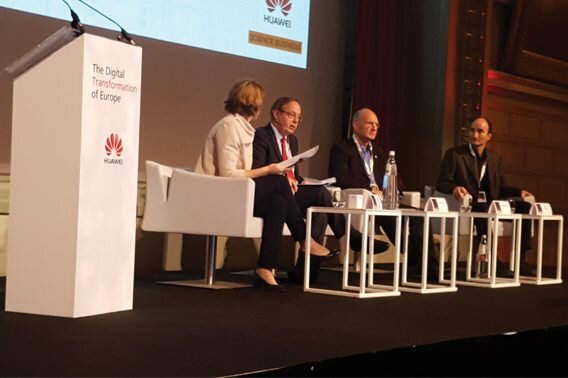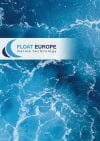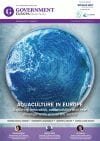
At Huawei’s Second European Academia Salon, Patrick Child of DG RTD spoke about his department’s proposals on the EU’s next framework programme.
The summer of 2017 marked the mid-point of the EU’s Horizon 2020 framework programme, a research and innovation funding initiative spanning 2014-2020 which is designed to support novel projects addressing a number of societal concerns. The release of an interim report evaluating the progress made under Horizon 2020 up until mid-2017 has fuelled significant discussion and speculation about what the next framework programme might contain, how it may be structured, which elements it will retain from Horizon 2020, and what role those people and projects that are seeking funding can play in shaping it. Further, the European Commission will begin soliciting proposals for the next programme, Framework Programme 9 (FP9), in 2018, meaning that many departments have already begun preparing their proposals and setting their priorities.
Research and innovation
At the Huawei’s Second European Academia Salon on the Digital Transformation of Europe, held in Brussels, Belgium, on 24 November, Patrick Child, deputy director general of the EU’s Directorate-General for Research and Innovation (DG RTD), shared his perspective on the matter, and offered some insight into the proposals that the DG is currently developing for a prospective FP9. He began by describing the current situation in Europe as the basis upon which the next framework programme will seek to build: “Europe has some real strengths to draw on and a very strong manufacturing base in a range of sectors – such as transport or healthcare – where we are very much at the cutting edge of introducing the digital revolution into the way that we work. [Commission President Jean-Claude] Juncker has put industrial modernisation at the centre of the commission’s agenda, particularly with the Digital Single Market and Energy Union.”
However, Child identified one downfall of Horizon 2020 which is that while Europe has many excellent centres of innovation which often produce world class ideas, there lacks the same path to commercialisation that is seen in other places. For example, California’s Silicon Valley is a tight-knit hub of business and innovation which allows research to be financed, developed into a product, and enter the market far more quickly than is possible in Europe’s current system. Child said that this was something that had been under discussion, not only within DG RTD, but with Commissioner for Research, Science and Innovation Carlos Moedas himself: “Where I think we face the biggest challenge is getting those good ideas, which come from our excellent universities and research community, into the commercial world. That’s what we need to think about for the next framework programme.”
It is not clear yet how FP9 might approach bridging this divide, because as Child himself acknowledged, the creation of new partnerships between researchers, companies and sources of public funding, is also a central theme of Horizon 2020. Innovative projects with public and private support, he continued, make investment in European research an attractive prospect, and so however this is approached, it is clear that the need to form partnerships which will commercialise projects will form something of a backbone for the DG’s proposals.
A growing innovation ecosystem
The deputy director general also took the opportunity to acknowledge some successful examples of this facilitated by Horizon 2020, which are already providing interesting developments in parts of Europe and may offer something of a direction for FP9 to proceed in: “In the area of artificial intelligence robotics, we’re working together with a private public partnership with the industry, where we are putting in about €1bn over the course of the framework programme, matched with €2.1bn from private investment, to really give a boost to this sector in the European Union.
“Another example, to underline the attractiveness of working in this area in Europe, was a recent decision by IBM to base its global research centre for artificial intelligence and internet of things (IoT) in Munich, Germany, with a 1,000-strong research community. That shows that Europe is very much on the map and we’ve got a lot to offer.”
This demonstrates that steps are indeed being made to facilitate greater co-operation between corporations and researchers, but also emphasises how important this is for Europe as a world leader in many scientific fields.
Developing this status further will require additional support from the next framework programme. As Child sees it, one of the challenges inherent in the current system is that projects are funded in a way that does not sufficiently reduce risk for investors. “[We need] to reduce the risk for European operators to get their good ideas out into the marketplace, and I think that is the single most important thing that we need to work on. It will be one of the key themes in the proposals that we’re working on now for the next framework programme.”
An EIC mandate
Thankfully, Child continued, an idea that Moedas had already discussed, and which is being developed by DG RTD, may offer a potential solution. “[There’s] this idea of producing a European Innovation Council (EIC) which will promote bottom-up research, simplify our funding landscape, and put companies and operators in a position to exploit the ideas that our research community is so good at generating in a much more swift and effective way.”
Plans for the EIC are already under way in the form of a pilot scheme, which is offering €2.7bn in funding for the period 2018-2020, during which time it will also develop best practice and offer strategic advice in order to refine and upgrade Europe’s innovation ecosystem. One of the proposals being made to the commission for FP9 is for a fully-fledged EIC, enshrining its mandate, organisational form, governance and budget, to begin operation as early as 2021.
In addition to acting as a strong funding base and facilitating partnerships between industry and academia, the deputy director general expressed optimism that the EIC could play a role in reshaping people’s perspectives about such interactions: “We have a cultural challenge in the European research community – particularly in some universities – that the idea of a close, symbiotic relationship with business is somehow impure or incorrect. There, we have to work very hard, and I think the EIC can help by providing a much more responsive and business-driven approach to the way we support innovation, and to encourage people with good ideas to take initiative and make them a success.”
Currently, this type of divisive thinking also has a negative impact on discussions around the shaping of funding which could impact FP9 proposals if not mitigated. Child explained: “One of the features of our debate on future funding is that we tend to see it as a tug of war between, on the one hand, support for industry and innovation, and on the other, support for basic research.” This approach is unsustainable if Europe wants to continue as a world-leading research base. “If we’re going to make things work in a more effective way, we need to see all those as part of a single piece. We need the confidence to produce instruments which give money to really creative scientists, whether they’re working in academia, industry, or their own small businesses.”
This refocusing of the approach, to be driven by innovative ideas and intelligent people, will form a core tenet of DG RTD’s FP9 proposals.
Public consultation
While these concerns were apparent thanks to the interim H2020 evaluation, and Child’s work with the DG for research and innovation, he stressed that it has also been an important process to consult with stakeholders that are on the receiving end of the funding structure, to try to address any challenges they may face. One of the strongest messages he received from public consultations with all sectors was that the overall size of the Horizon 2020 budget has led to a low success rate: “We don’t always have enough funds to support all of the excellent ideas that come forward,” he lamented. “We can perhaps address that by increasing our synergies with other EU funding programmes, such as the structural funds. That’s something that we’re working on.”
In fact, one of the DG’s proposals will enshrine public consultation into the legislation of FP9, and into the structure of the funding instrument itself. “The idea of building the next framework programme around a number of missions, with cross-cutting objectives that are perhaps easier to understand and relate to for Europe’s citizens, is something that we’ve been working on,” Child explained. “The next phase of consultation is likely to be on the concept of these missions. Commissioner Moedas would like to hear from anybody with good ideas on what these missions should look like. We’ve got preliminary ideas but we want to have real engagement with all stakeholders in the next few months, before we present our legislative proposals in the spring.”
For this reason, it is unlikely that the missions themselves will be established in the legislation, allowing for some flexibility in addressing changing priorities over the lifespan of the programme, and to ensure that public opinion can still be taken into account. Child said: “The concept of missions will be established, but the next multiannual financial framework will only start in 2021, and so if we start to hardwire into the legislation what the key issues should be, we risk seeing ourselves overtaken, especially in an area like the Digital Single Market.”
It seems that these missions – the concept of which may be analogous to Horizon 2020’s pillars – will form the basis of the funding structure of FP9, and Child offered some examples of how they might be specifically targeted to addressing contemporary concerns: “We have several examples, like having carbon neutral cities in Europe, finding a cure for Alzheimer’s disease, or dealing with the problem of plastic pollution in the sea. The key element is that these things speak to the general public.”
The involvement of the general public is vital, Child went on, because it makes it easier to communicate which topics can, if they receive funding, contribute added value at a European level, rather than those which might be better funded under national programmes.
As well as appealing to the European public at large, the other element of these missions should be the possibility of cross sectoral collaboration. Child compared his vision for the next framework programme to the American space programme, saying: “Putting a man on the moon produced all sorts of spin-off benefits and technologies. Even if we don’t achieve [the missions], maybe we will foster some really important discoveries.”
This vision of specific missions, closer collaboration between disciplines and stronger relationships between public and private stakeholders certainly suggests that Child and his directorate general have learned from some of the shortcomings of Horizon 2020, and are set to propose a new structure for the next framework programme which will offer better opportunities and better results, with more focused goals to create a targeted impact on the lives of Europeans.
This article will appear in Pan European Networks: Government 24, which will be published in January, 2018.



















